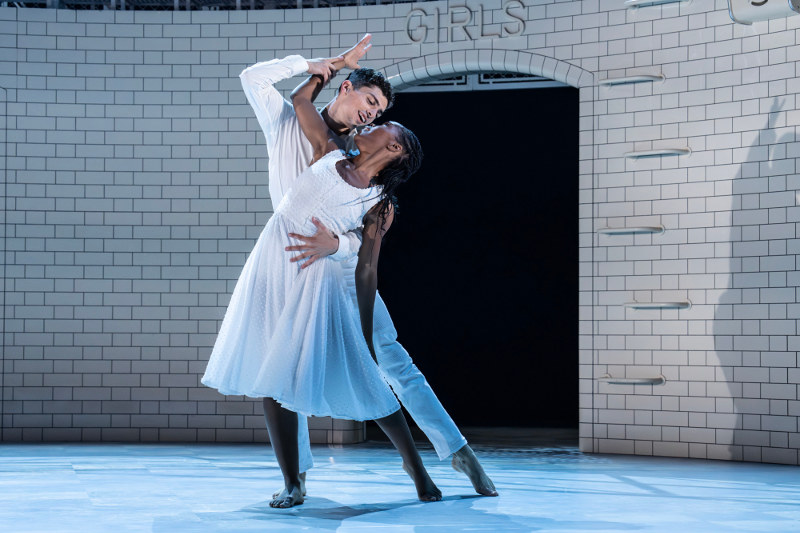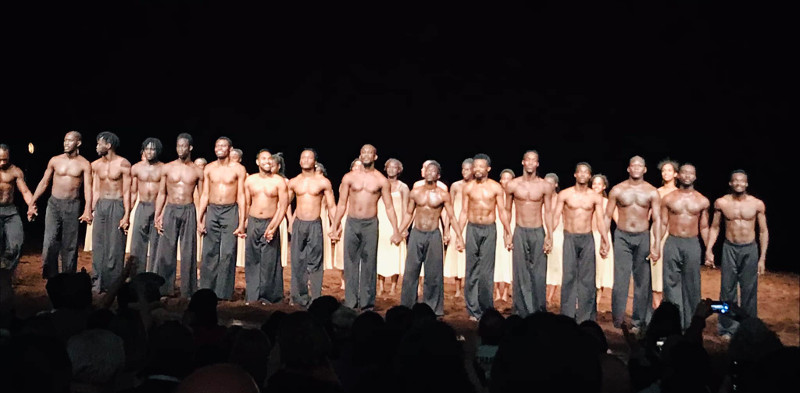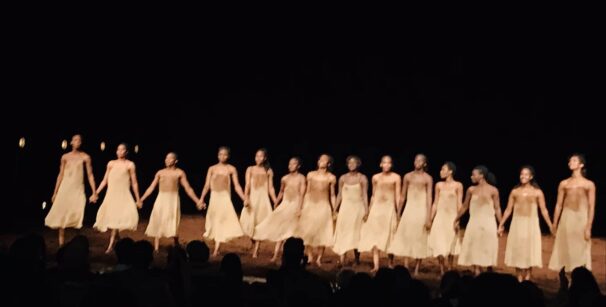
director/choreographer matthew bourne, photo credit: johan persson
It warmed my dance critic’s heart to see swarms of Angelenos flocking onto the Plaza of the Los Angeles Music Center to enjoy two impressive and complex dance showcases, both running, separately, at the stalwart performing arts center’s active houses.
The 2,000-seat Ahmanson Theater is mid-run in an exclusive weeks-long engagement of director-choreographer Matthew Bourne‘s latest, his 2019 adaption of a theatrical classic, “Romeo and Juliet.” The design-driven danced version of a centuries-old tale of social dysfunction Mr. Bourne stages in a setting much resembling a mental asylum of early 20th century.
The Music Center’s equally barn-scaled, 3,000-seat Dorothy Chandler Pavilion is hosting the showcase of yet another dance-classic redux — choreographer Pina Bausch (1940-2009)’s seminal “The Rite of Spring” created for her Tanztheater Wuppertal company in 1975. Bausch’s work, a revelation in its day, is itself a rumination (if this ferocious ballet may be labeled that) on the mother of all “Rite”s, that choreographed by Nijinsky for the Ballets Russes in 1913.
It was Pina Bausch’s son, Salomon, who had the concept of restaging his mother’s chef d’ouevre, only “performed by dancers with a variety of dance backgrounds, assembled specifically for that purpose,” as he told dance critic Marina Harss for the New York Times. Reaching out to the well regarded École des Sables in Senegal, the long journey of this revived “Rite” this weekend reached the Music Center’s shores.
Whew! It’s a lot of dance history on Bunker Hill. In 2013, the Chandler hosted an historic centennial restaging of the Diaghilev “The Rite of Spring” to live orchestra, danced in a close approximation of Nijinsky’s original choreography and Bakst’s costumes scrupulously researched and reconstructed by Kenneth Archer and Millicent Hodson for The Joffrey Ballet. In today’s much-changed times, Glorya Kaufman Presents Dance at the Music Center invited a specially convened troupe of superb African dancers to deliver the pagan ritual dance — and stomp, skid, leap, crawl, and roll in what looked like six inches of peat moss physically underpinning Bausch’s heart-throbbingly intense choreography.
In the course of performing it, a cloud of dirt dispersed over the audience and Dorothy Chandler’s peach velour seats like a case of secondary cigarette smoke. One viewer told me he felt claustrophobic, and began a panic attack. Others felt hot. For me, the dancers, so disciplined, beautifully rehearsed, and so furiously committed to their task, would have benefited by the loss of ten of their ranks from the stage. They seemed very constrained, and I’m wondering if that jammed stage is why this exceptional choreographic work felt so uncomfortable for me. Not that it’s remotely meant to feel “comfortable”–and yet there was a disconnect. Disappointing was the use of recorded music on the Chandler’s less-than-excellent sound system. Another comedown was the program opener, the “common ground[s]” duet for Malou Airaudo, a former Bausch dancer, and Germaine Acogny, a respected Senegalese dancer/choreographer. The obscure dance-theater foray by two estimable former dancers, when followed by the half-hour break while the peat was raked onto the stage, transformed a highly anticipatory audience into a dullened one. These shortcomings aside, the impact of Bausch’s hugely organic choreography, forceful in its use of unison primitive movement that rose and fell on the shock waves of Stravinsky’s musical momentum; and, most brilliantly, the leaps of the ladies directly onto shoulders of the men right on Stravinsky’s accented cues (which Bausch, a show woman, repeats a second time so you can see how it’s done); all this rendered “The Rite of Spring” a memorable experience.

British dance-theater man Matthew Bourne, whose rare established dance brand has eternal resonance for his marvelous, historic, reinvention of Swan Lake in 1995, has the Ahmanson Theatre (and its producer Center Theater Group) as a regular U.S. outpost. His Swan Lake, Cinderella, Car-men and Play Without Words have all had presentation there.
In Southern California, audiences have lately paid myriad respects to the dearly departed Ms. Capulet and Mr. Montegue. Since 2018, the two weird COVID years excepted, we have had a plethora of R&Js, courtesy of Ballet BC (Wahlerski at The Soraya); L.A. Dance Project (Millepied at Segerstrom); Les Ballets de Monte Carlo (Maillot, again Segerstrom); The Joffrey (Pastor, Music Center). Then came Mr. Spielberg’s movie and the ancillary West Side Storyania. Bourne’s version chops poor Prokofiev’s score and uses it, rearranged, to enact R&J’s themes in Lez Brotherston‘s wicked set, as cold and sterile as the inside of a freezer. Brotherston, too, garbed the dancers in ragamuffin non-costumes as though taking a yoga class.

My concern with Bourne’s ballet is the addition of violent and, dare I suggest, sick back stories that simply don’t meld. We meet Juliet, and just as quickly, she’s under threat by a mean-looking guard, the erstwhile Tybalt, who, from miles and minutes away, Mr. Bourne signals is planning a rapey-rapey. And rape Juliet Tybalt does; mercilessly, this happens out of the audience’s sight. Enter Romeo, who, too, is mauled and stripped by the local guy gang. Does he like it? Does he hate it? We’ll never know. Soon it’s time for the Dance at the Gym, er… the gym of the Insane Asylum. Bourne’s choreography, which I find rudimentary, even cloddish (literally there is much marching around, sometimes with a lean to the left or a decorative arm poking that direction), leaves in ambiguity how these two traumatized youngsters are able to hook up. These kinds of theatrical puzzles I feel, especially in a narrative context, are the onus of the creator to clarify, not the audience to decipher. By the time a lengthy foreshadowing indicated payback time for Tybalt, I averted my eyes sparing myself the sight of my first-ever leather-belt strangulation by a ballet mob. Departing this vile production. Bourne’s choices left me feeling covered in dirt — and thanks to “The Rite of Spring” a few nights later, I actually was!

Dance critic Debra Levine founded artsmeme in 2008.
